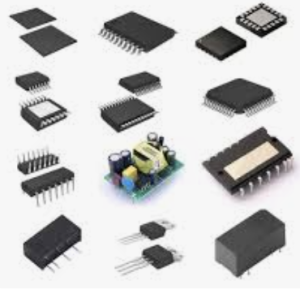
Integrated Circuit (IC) chips, the silicon marvels that power modern technology, have revolutionized consumer electronics, embedding intelligence into devices that shape daily life. From smartphones to smart homes, IC chips drive innovation, enabling advancements in processing power, connectivity, and energy efficiency. This article explores their evolution, applications, benefits, challenges, and future trends.
1. The Evolution of IC Chips
The journey began in 1958 when Jack Kilby at Texas Instruments created the first IC, integrating multiple components onto a single semiconductor. Gordon Moore’s 1965 observation, Moore’s Law, predicted the doubling of transistors every two years, propelling miniaturization and performance gains. By the 21st century, System-on-Chip (SoC) designs combined processors, memory, and sensors into single chips, exemplified by Apple’s M1 and Qualcomm’s Snapdragon. Today, 3D ICs and 5nm fabrication processes push boundaries, though Moore’s Law faces physical limits.
2. IC Chips in Consumer Electronics: Category-wise Analysis
Smartphones & Tablets: ICs manage CPUs, GPUs, modems (e.g., 5G chips), and AI accelerators, enabling features like facial recognition.
Computers: Modern CPUs (e.g., Intel Core i9) and GPUs (NVIDIA RTX) deliver desktop-level performance in laptops.
Home Entertainment: 4K TVs use image processors (Sony’s X1 Ultimate), while gaming consoles (PS5) rely on custom APUs.
Home Appliances: Smart refrigerators (Samsung Family Hub) use IoT-enabled ICs for inventory tracking.
Wearables: Fitness trackers (Fitbit) leverage low-power MCUs for health monitoring.
Automotive: Electric vehicles (Tesla) depend on power management ICs and AI chips for autonomous driving.
3. Benefits Enabled by IC Chips
Miniaturization: Devices shrank from room-sized computers to pocketable smartphones.
Power & Efficiency: Enhanced performance with lower energy use (e.g., ARM chips in mobile devices).
Cost Reduction: Mass production lowered prices, democratizing access to technology.
Connectivity: Wi-Fi/Bluetooth chips (Broadcom) enable seamless IoT ecosystems.
AI Integration: Dedicated NPUs (e.g., Google’s Tensor) power real-time language translation and photography.
4. Challenges and Considerations
Supply Chain: The 2020–2022 global chip shortage highlighted dependencies on TSMC and Samsung.
Environmental Impact: Semiconductor manufacturing consumes vast water/energy; e-waste is a growing concern.
Security: IoT devices face vulnerabilities; solutions include hardware-based encryption (Apple’s Secure Enclave).
Technological Limits: As Moore’s Law slows, innovation shifts to architectures like 3D ICs and new materials.
5. Future Trends and Innovations
Beyond Silicon: Graphene and gallium nitride promise faster, efficient chips.
Quantum Computing: Companies like IBM explore quantum ICs for unprecedented processing.
Biodegradable Electronics: Researchers develop transient chips to reduce e-waste.
AI-Optimized Hardware: Neuromorphic chips (Intel Loihi) mimic neural networks for adaptive learning.
Conclusion
IC chips are the cornerstone of the digital age, transforming consumer electronics into smart, interconnected systems. While challenges like sustainability and security persist, advancements in materials and AI herald a future where technology becomes even more integrated into daily life. As the industry evolves, IC chips will continue to drive innovation, shaping a smarter, more connected world.
- Everything You Need To Know About Limit Switch - May 21, 2025
- Everthing You Should Know About Rheostat - May 20, 2025
- Everything You Need To Know About Reversing Contactor - May 19, 2025






